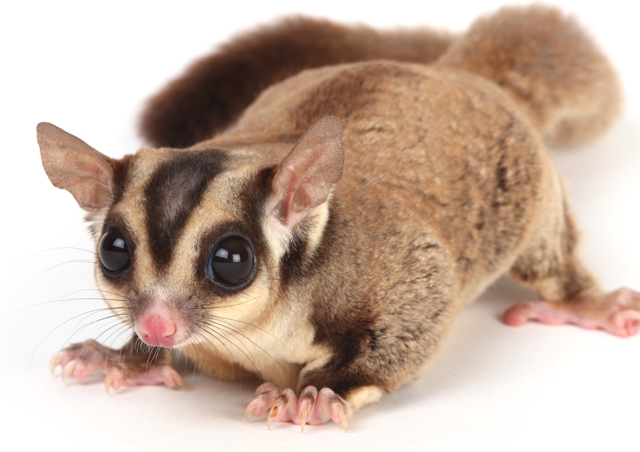If you're looking for a unique, playful, and downright adorable pet, sugar gliders might just steal your heart. These tiny marsupials are social, quirky, and full of personality, but owning one isn’t for everyone. In this guide, we’ll dive into everything you need to know about sugar gliders, from what makes them special to how to care for them.

Sugar gliders (Petaurus breviceps) are small, nocturnal marsupials native to Australia, New Guinea, and Indonesia. They get their name from their love of sweet foods and their ability to glide through the air using a membrane between their limbs. Think of them as tiny flying squirrels, but cuter and with a pouch like a kangaroo!
Adult sugar gliders weigh about 4-5 ounces and are around 6-7 inches long, not including their bushy tail. Their big round eyes help them see at night, and their soft fur makes them feel like little bundles of joy in your hand.
Adorable and Social: These little guys are incredibly cute and love interacting with their owners. They bond deeply with their humans, often forming lifelong connections.
Unique Features: Watching a sugar glider soar from one perch to another is pure magic! Their gliding ability is not just entertaining—it’s also part of their natural behavior.
Compact Size: They’re small enough to live comfortably in an apartment or small house.
But, let’s be honest—they aren’t the easiest pets to own. They require commitment, patience, and a lot of love.
Sugar gliders can make fantastic pets for the right person, but they’re not for everyone. Here are the pros and cons:
Social Creatures: They thrive on interaction and can form strong bonds with their humans.
Long Lifespan: With proper care, sugar gliders can live up to 10-15 years, making them a long-term companion.
Low Odor: When kept clean and fed properly, they have very little smell compared to other small pets.
Nocturnal: They’re most active at night, which can be a challenge if you’re an early sleeper.
Specialized Care: Their diet and environment require more attention than a typical hamster or guinea pig.
Social Needs: Sugar gliders hate being alone. You’ll need at least two of them or be prepared to spend a lot of time keeping them company.
Sugar gliders need a spacious cage to climb and explore. Look for one that’s at least 24x24x36 inches, with bars spaced no wider than half an inch. Add lots of toys, branches, and hammocks to keep them entertained.
Temperature: They prefer a warm environment, ideally between 75-80°F.
Nest Box: Line a pouch or nesting box with fleece for them to sleep in.
Their diet can be a bit tricky because they need a balance of protein, fruits, and veggies. Here’s what a typical sugar glider meal plan might look like:
Protein: Boiled chicken, eggs, or specially formulated sugar glider food.
Fruits & Veggies: Apples, melons, carrots, and leafy greens. Avoid anything toxic like avocado or chocolate.
Calcium & Supplements: They’re prone to calcium deficiency, so you may need to add supplements.
Make sure fresh water is always available.
Sugar gliders are incredibly social animals. In the wild, they live in colonies, so keeping them alone can lead to depression. Ideally, you should adopt them in pairs or groups. If you only have one, be ready to dedicate a lot of time to bonding.
Getting a sugar glider to trust you takes time and patience.
Carry Them Around: Use a bonding pouch to keep them close to you during the day.
Hand-Feeding: Offer treats like mealworms or small bits of fruit to earn their trust.
Be Patient: It might take weeks or even months for them to fully bond with you, but the effort is worth it.
Sugar gliders are generally healthy but can suffer from:
Nutritional Deficiencies: A poor diet can lead to metabolic bone disease.
Parasites: Keep an eye out for mites or fleas.
Stress-Related Problems: Loneliness or an unclean environment can cause stress.
Regular vet check-ups with an exotic animal specialist are essential.
Q: Are sugar gliders good pets for kids?
A: Not really. Sugar gliders require delicate handling and a lot of care, which may be too much responsibility for young kids.
Q: How much do sugar gliders cost?
A: The initial cost for a sugar glider ranges from $100-$500, depending on the breeder. Don’t forget the cage, toys, and food, which can add another $200-$400.
Q: Do sugar gliders bite?
A: They might nibble or bite if scared, but with proper bonding, this behavior usually disappears.
Q: Can I keep just one sugar glider?
A: It’s possible, but not recommended. Sugar gliders are social animals and can become depressed if left alone.
Sugar gliders are amazing, one-of-a-kind pets that can bring a lot of joy to your life. However, they’re not a casual commitment. Their care requires time, effort, and a willingness to learn. If you’re ready to put in the work and can provide a loving home, sugar gliders will reward you with endless affection and adorable antics.
So, are you up for the challenge? If yes, get ready to welcome these gliding bundles of joy into your life!
animal tags: Sugar-gliders Petaurus-breviceps
We created this article in conjunction with AI technology, then made sure it was fact-checked and edited by a Animals Top editor.